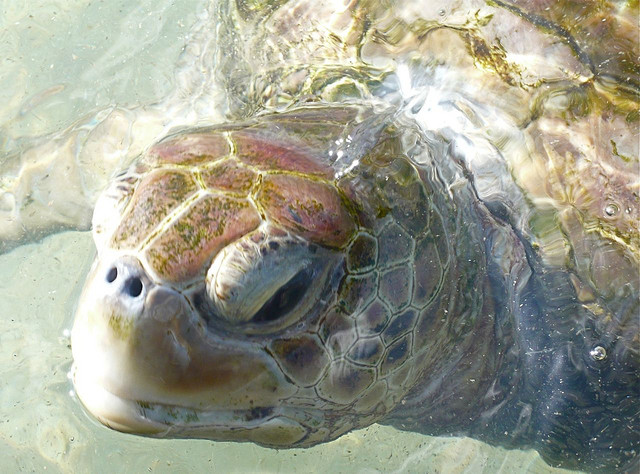
Sea Turtle - Image by MRHSfan - flickr
Since the humans got interaction with the turtles or tortoises, they are considered the dignified creatures of God. This is an ancient thinking that the turtles carry the burden of the mother earth. In some parts of the world, turtles were the symbol of life and in some other parts; they did personify the immortality and fertility. They have also great significance in various religions and mythologies, as they represented steadfastness and tranquility. Overall, the tortoises and turtles have a peaceful and intellectual status in the global culture.
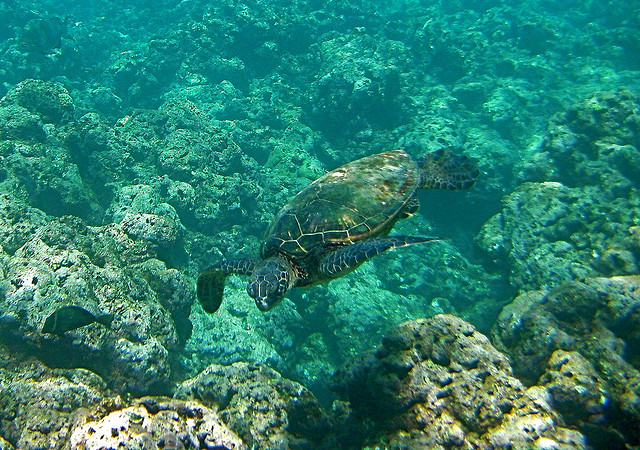
The use of the terms ‘turtle‘, ‘tortoise‘, and ‘terrapin‘ is not straightforward. All animals with a shell and backbone are classified as turtles, and the word turtle is used to describe all members. So far there are seven species of Marine Turtle or Sea Turtle which have recognized status. Sea turtles belong to the Class Reptilia, Subclass Anapsida and Order Testudines. The conservation status of all 7 species of Sea Turtles is critically endangered. These seven species of marine turtles are found worldwide except Arctic and of these, five have been recorded in Europe. Sea turtles feed on a wide range of animals and plants. They are mostly omnivorous in their adult life, except the green sea turtle which is herbivorous, changing from a carnivorous diet when young.
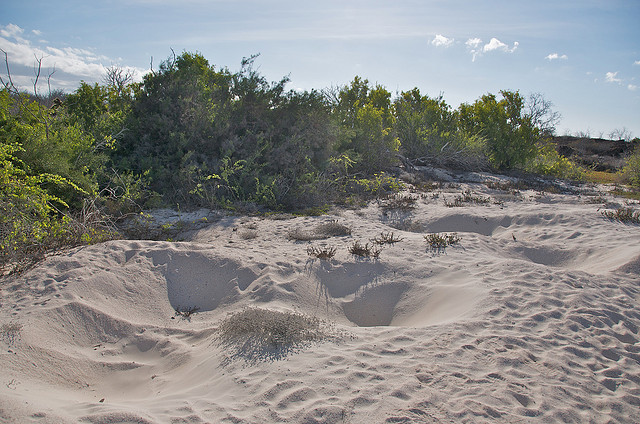
The natural habitats of the Sea turtles or Marine Turtles are the waters over continental shelves. They are normally submerged creatures and they need to breathe air from the water surface. The Sea Turtles usually refill their lungs with a single explosive exhalation and rapid inhalation when they come to water surface but under unavoidable circumstances, they may divert to anaerobic metabolism for long periods of time. Sea Turtles have an average life span of 80 years and it takes decades for sea turtles to reach sexual maturity. The couple normally mates at sea and after mating at sea, adult female sea turtles return to land to nest at night. The females normally prefer to hatch on the beach and build a circular nest and after the hole is dug, the female then starts filling the nest with a clutch of soft-shelled eggs one by one until she has deposited around 50 to 200 eggs, depending on the species. Incubation takes about two months. The eggs in one nest hatch together over a very short period of time. When ready, hatchlings tear their shells apart with their snout and dig through the sand. There is a brief about all 7 species of Sea Turtles for your interest;
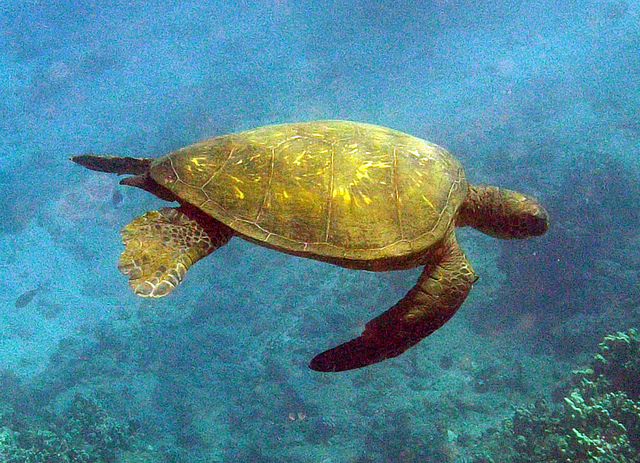
1- The green sea turtle (Chelonia mydas), also known as the green turtle, black (sea) turtle, or Pacific green turtle, is a large sea turtle of the family Cheloniidae. It is the only species in the genus Chelonia. Its range extends throughout tropical and subtropical seas around the world, with two distinct populations in the Atlantic and Pacific Oceans. The common name comes from the usually green fat found beneath its carapace. Adults are 3 to 4 feet in carapace length (83 – 114 cm). The green turtle is the largest of the Cheloniidae family. The largest green turtle ever found was 5 feet (152 cm) in length and 871 pounds (395 kg). Adults weigh between 240 and 420 pounds (110 – 190 kg).
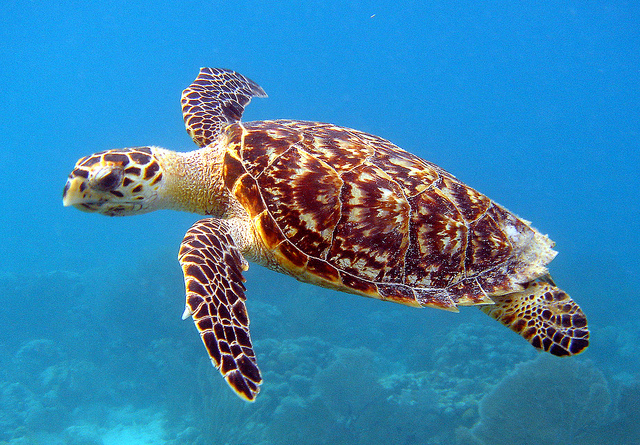
2- The hawksbill sea turtle (Eretmochelys imbricata) is a critically endangered sea turtle belonging to the family Cheloniidae. It is the only extant species in its genus. The species has a worldwide distribution, with Atlantic and Pacific subspecies. The hawksbill’s appearance is similar to that of other marine turtles. It has a generally flattened body shape, a protective carapace, and flipper-like arms, adapted for swimming in the open ocean. Hawksbill shells slightly change colors, depending on water temperature. While this turtle lives part of its life in the open ocean, it spends more time in shallow lagoons and coral reefs.
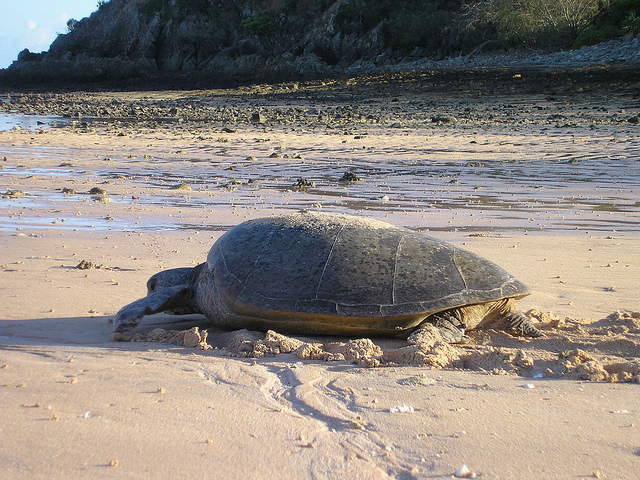
3- The flatback sea turtle (Natator depressus) is a sea turtle endemic to the continental shelf of Australia. Flatback turtles belong to the sea turtle super family Cheloniidae and are the only species found in the genus Natator. Flatback turtles are usually found in bays, shallow, grassy waters, coral reefs,estuaries, and lagoons on the northern coast of Australia and off the coast of Papua New Guinea. The species is considered vulnerable to extinction in Western Australia, but the Red List of the IUCN regards it as data deficient and unable to be correctly assessed.
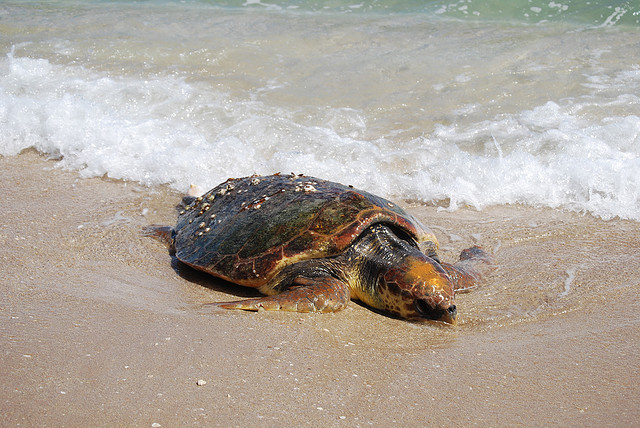
4- The loggerhead sea turtle (Caretta caretta), or loggerhead, is an oceanic turtle distributed throughout the world. It is a marine reptile, belonging to the family Cheloniidae. The average loggerhead measures around 90 cm (35 in) long when fully grown, although larger specimens of up to 279.4 cm (110.0 in) have been discovered. The adult loggerhead sea turtle weighs approximately 135 kg (300 lb), with the largest specimens weighing in at more than 454 kg (1,000 lb). The skin ranges from yellow to brown in color, and the shell is typically reddish-brown. No external differences in gender are seen until the turtle becomes an adult, the most obvious difference being the adult males have thicker tails and shorter plastrons than the females.
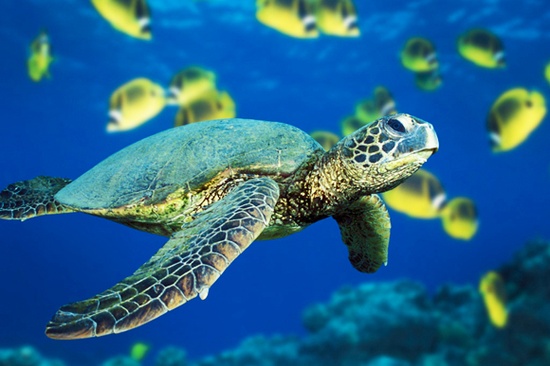
5- Kemp’s ridley sea turtle (Lepidochelys kempii), or Atlantic ridley sea turtle is the rarest sea turtle and is critically endangered. It is one of two living species in the genus Lepidochelys (the other one being L. olivacea, the olive ridley sea turtle). Kemp’s ridley is a small sea turtle species, reaching maturity at 60–90 cm (24–35 in) long and averaging only 45 kg (99 lb). Typical of sea turtles, it has a dorsoventrally depressed body with specially adapted flipper-like front limbs and a beak. Kemp’s ridley sea turtles generally prefer warm waters but inhabit waters as far north as New Jersey, They migrate to the Gulf of Mexico, and Florida where they often inhabit the waters off Louisiana. Their range includes the Atlantic Ocean and the Gulf of Mexico. Almost all females return each year to a single beach—Rancho Nuevo in the Mexican state of Tamaulipas—to lay eggs. Some travel as far away as the coast of Ireland.
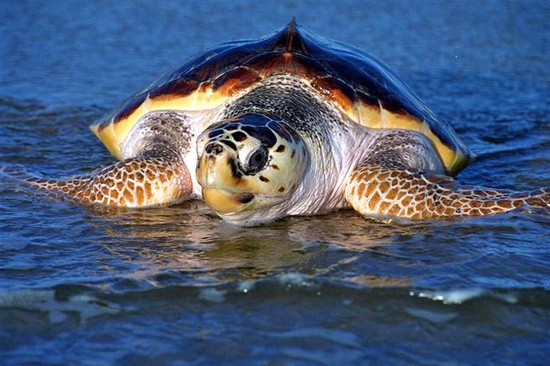
6- The olive ridley sea turtle (Lepidochelys olivacea), also known as the Pacific ridley sea turtle, is a medium-sized species of sea turtle found in warm and tropical waters, primarily in the Pacific and Indian Oceans. The olive ridley is a small sea turtle, with an adult carapace length averaging 60 to 70 cm.The heart-shaped carapace is characterized by four pairs of pore-bearing inframarginal scutes on the bridge, two pairs of prefrontals, and up to 9 lateral scutes per side. Olive ridleys rarely weigh over 50 kg (110 lb). A study in Oaxaca, Mexico, reported a sample of adults ranged from 25 to 46 kg; adult females weighed an average of 35.45 kg (n=58), while adult males weighed significantly less, averaging 33.00 kg (n=17). Hatchlings usually weigh between 12.0 and 23.3 g.
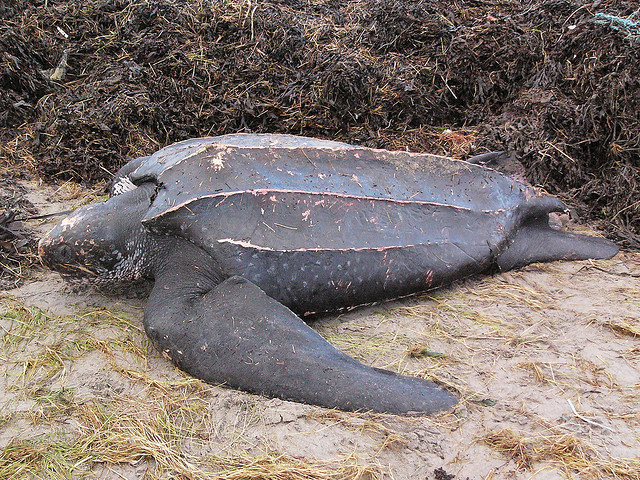
7- The leatherback turtle (Dermochelys coriacea), sometimes called the lute turtle, is the largest of all living turtles (as well as the largest extant sea turtle) and is the fourth largest modern reptile behind three crocodilians. It is the only living species in the genus Dermochelys. It can easily be differentiated from other modern sea turtles by its lack of a bony shell. Instead, its carapace is covered by skin and oily flesh. Dermochelys coriacea is the only extant member of the family Dermochelyidae. The leatherback has several characteristics that distinguish it from other sea turtles. Its most notable feature is the lack of a bony carapace. Instead of scutes, it has thick, leathery skin with embedded minuscule osteoderms. Seven distinct ridges rise from the carapace, crossing from the anterior to posterior margin of the turtle’s back. Leatherbacks are unique among reptiles in that their scales lack β-keratin. The entire turtle’s dorsal surface is colored dark grey to black, with a scattering of white blotches and spots. Demonstrating countershading, the turtle’s underside is lightly colored. Instead of teeth, the leatherback turtle has points on the tomium of its upper lip, with backwards spines in its throat to help it swallow food.
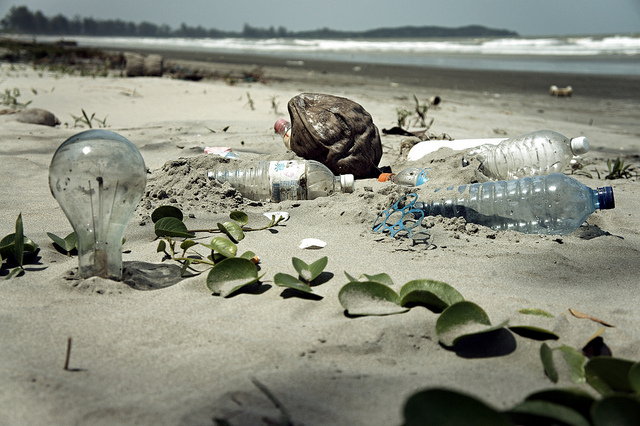
Dear readers; the sea turtles are the ancient ocean dwellers of the lovely planet. All the seven species of the Sea Turtles or Marine Turtles are either critically endangered or threatened. According to the latest research, their population in the past two decades is dangerously decreased. There are many serious threats to the life of the Sea Turtle. There is large-scale poaching of the adult turtles and their eggs. Many fshermen drag the sea turtles that stuck in their shrimp nets set to catch tuna and swordfish. The destruction of their natural habitats and spoiling of their nesting beaches are also creating a worst situation for Sea Turtles. Marine pollution and throwing hazardous waste like plastic debris in the oceanic waters and many other factors like Climate Change are causing rising sea levels that impact nesting beaches. Warming ocean temperatures are also likely to negatively impact the food resources for sea turtles and virtually all marine species. Global Warming, gasoline and petrolium activities on the sea ports and the installation of refineries are making the world wide population of all the 7 species of sea turtles critically endangered.